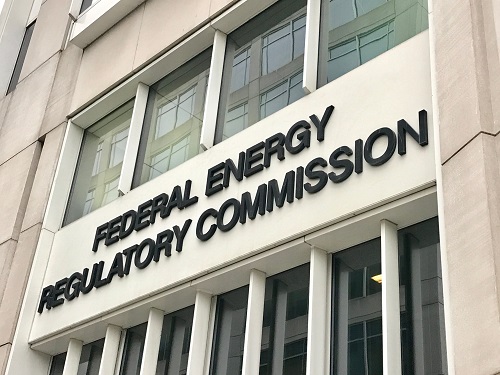December 2022, Vol. 249, No. 12
Government
FERC Rejects Environmental Concerns About Gas Pipeline Projects

By Stephen Barlas, Contributing Editor, Washington, D.C.
(P&GJ) — The Federal Energy Regulatory Commission (FERC) continues to dispatch environmental objections to pipeline projects. Even Chairman Richard Glick, who had originally made reducing greenhouse gas (GHG) emissions his guiding light, is turning a deaf ear.
Facing the end of his term and undoubtedly worried about casting votes viewed as anti-pipeline, which might produce opposition to his Senate renomination, Glick and another Democratic commissioner, Allison Clements, voted with the three other commissioners to approve a 24-mile (39-km) Texas Gas pipeline by a vote of 5-0 on Oct. 20, despite a number of environmental objections from the Sierra Club and a group called Citizens Action Coalition of Indiana (CAC).
In a second recent instance, FERC staff dispatched environmental concerns about the already-in-operation Spire STL pipeline in a final environmental impact statement (EIS) on Oct. 7, which rejects demands by the Sierra Club and Environmental Defense Fund to calculate upstream GHG emissions, address methane leaks from pipelines and in some way limit the pipeline’s operations because of air and noise pollution impacts on environmental justice (i.e., minority) communities.
Spire is operating on a temporary certificate and FERC conducted an EIS after a federal appeals court in Washington remanded the project back to FERC in June 2021 because of a failure to properly consider an affiliate relationship between Spire STL and Spire Energy. FERC has not issued a decision on the affiliate issue yet.
The two Sierra Club attorneys who filed briefs in each of those two cases did not reply to requests for comments.
In both the Spire and Texas Gas dockets, the staff and commissioners frustrated environmentalists.
“The law clearly requires FERC to consider all reasonably foreseeable effects of gas projects, including their upstream and downstream effects. FERC is wise to apply the law, rather than dodge it,” said Gillian Giannetti, the top FERC-watcher at the Natural Resources Defense Council (NRDC).
But while FERC refused to consider upstream GHG emissions in both cases, it has not categorically ruled that out, noted Giannetti.
“The gas industry has acted like Chicken Little, crying that FERC should never consider a project’s upstream and downstream emissions,” Giannetti added. “The fact that the industry is scared about FERC doing its job should be a red flag for anyone who cares about reducing greenhouse gas emissions.”
In the Henderson County Expansion Project, Texas Gas proposed to provide up to 220,000 MMBtu/d of new firm transportation service to CenterPoint’s new natural gas–fired electric generation turbines at the A.B. Brown Plant in Posey County, Indiana.
These will replace CenterPoint’s coal-fired generating facilities. The switch will result in a big drop in GHG emissions. FERC stated, “Assuming the natural gas–fired generation operates at a 100% load factor, replacing the two coal-fired units would result in a net reduction of 2,075,603 tons carbon dioxide equivalent (CO2 e) of GHG emissions per year.”
This should have been a big win for environmentalists. Nonetheless, the CAC and Sierra Club filed separate protests raising arguments regarding project need and environmental concerns, among them the supposed availability of non-gas alternatives, the failure to consider upstream GHG emissions, the potential damage to minority communities, the noise from construction and other issues.
The CAC demanded FERC hold public hearings, but the commission refused saying everyone who wanted to comment had ample opportunity to do so through scoping meetings and the public docket.
The CAC argued FERC had to supplement its draft EIS based on the Inflation Reduction Act, which will offer $400 billion in tax credits and directs spending to fund clean energy and transmission resilience investments.
The point was that those funds would make renewable resources more affordable for CenterPoint in conjunction with replacing the coal-fired combustion. Besides urging FERC to consider alternative portfolios for CenterPoint that are less reliant on new gas supply and allegedly could be developed at lower cost while reliably serving load, the group also wanted FERC to “seriously assess the potential for reducing environmental impacts via the electric compression alternative.”
Texas Gas pointed out that it is the Indiana Utility Regulatory Commission (IURC), not FERC, who is responsible for selecting the resources necessary to integrate CenterPoint’s renewable resources. FERC agreed saying, “The IURC specifically found that “The flexible and controllable nature of the gas CTs [combustion turbines] will support the intermittent nature of the renewable generation in [CenterPoint’s] Preferred Portfolio to ensure system reliability.”
The Sierra Club seconded the CAC’s arguments that FERC should have considered upstream GHG emissions in its EIS and that an associated failure was its refusal to characterize the project’s GHG emissions as “significant” or “insignificant.”
The National Environmental Policy Act (NEPA), some argue, requires that when GHG emissions are above a certain, as yet undetermined, level. FERC’s reason for not doing that was because the commission “is conducting a generic proceeding to determine whether and how the commission will conduct significance determinations going forward.”
That was a reference to a separate FERC draft policy statement issued earlier in 2022 that attempts to come to grips with factoring in GHG emissions into pipeline approval decisions.
In their “concurring” decision, Glick and Clements admitted, “The Henderson City Expansion Project would result in a substantial net decrease in GHG emissions when reasonably foreseeable downstream emissions reductions are considered.” But they quibbled, perhaps to resist completely parting political company with the Sierra Club, that the commission should have made a decision one way or another on “significance.” They added, “Accordingly, the Commission should apply our precedent, as well as our common sense, to find that the GHG emissions here are not significant.”
Environmentalists raised some of those same GHG issues in the case of the Spire STL pipeline and FERC staff again swept them aside when it published the EIS. FERC granted Spire STL a temporary certificate in December 2021 and undertook an EIS (a smaller environmental assessment was completed originally when the initial certificate was awarded in 2018) that the Appeals Court had not faulted in its 2021 remand.
Here again, the staff refused to consider upstream GHG emissions despite demands from environmentalists and the EPA. Putting an exclamation point on its refusal to do so, the staff wrote, “The specific source of the natural gas to be transported by the project is currently unknown and would likely change throughout the project’s operation. To date, the Commission has not found upstream emissions to be an effect of any proposed project…”
EIS stated, “We determined that impacts from the continued
operation of the Spire STL would be less than significant, with the exception of climate change impacts resulting from GHG emissions that are not characterized as significant or insignificant.”
Again, as in Henderson, Sierra and other environmental groups urged the commission to estimate total GHG emissions, including those upstream, and to total them as “significant.” But FERC staff said, “… it has not identified a methodology to attribute discrete, quantifiable, physical effects on the environment resulting from the project’s incremental contribution to GHGs.”
Nor has it found “an established threshold for determining the project’s significance when compared to established GHG reduction targets at the state or federal level.” The staff did look at the pipelines’ contribution to GHG emissions in Missouri and Illinois, projecting them to be 6.1% and 0.000006%.
FERC’s major concern voiced in the EIS is that continued operation of Texas Gas’s Laclede/Lange and Chain of Rocks Delivery Stations would have disproportionately high and adverse impacts on environmental justice communities because of visual, air, and noise impacts.
But the EIS concluded those impacts are less than significant. Spire filed a visual screening plan for both locations that FERC deemed adequate to solve the potential problems.






Comments